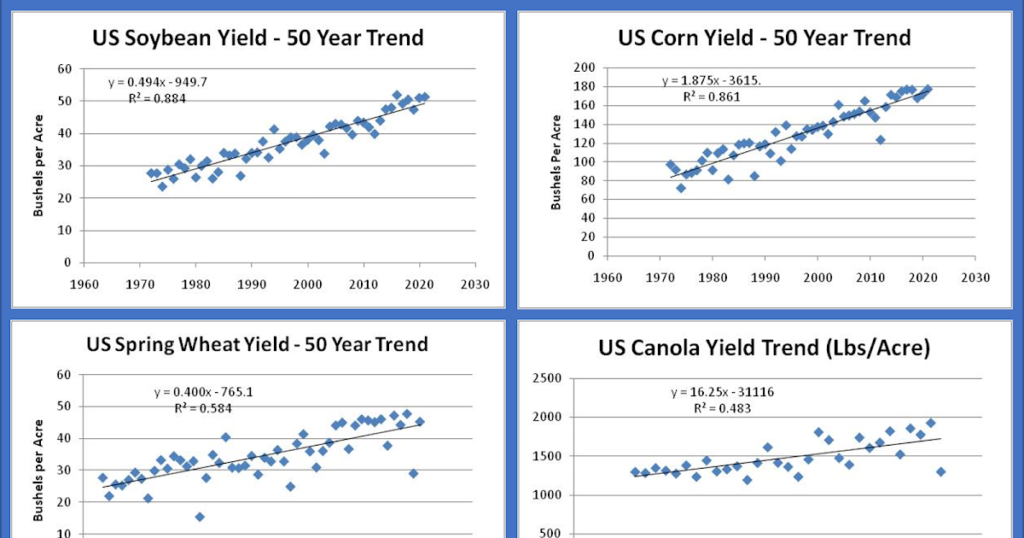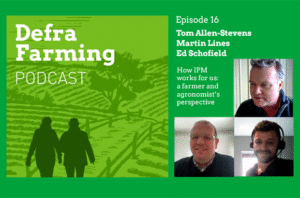
Sample Yield Trends.png
(This post was originally published on Forbes on 8/17/22)
Humanity depends on the agriculture sector to produce our food, feed, and fiber, and that demand continues to grow. Increasingly we look to crops as more climate-friendly sources for fuels, plastics and other “bio-materials.” The challenge is to fulfill this diverse and expanding demand without driving land-use-change (LUC)- the conversion of previously uncultivated lands to farms. LUC leads to the loss of biodiversity and a massive release carbon dioxide from those soils. Through the refinement of farming practices and the use of new technologies, the productivity of many major crops has been steadily increasing (see graphs below), but climate change may compromise that trend.
 |
| The per acre yield of major US crops has been increasing for decades (Graphs by author based on USDA-NASS Quickstats data) |
There is another way to expand crop production without adding new land – a farming method known as “double cropping.” In temperate climates there is normally one crop harvested from each acre each year. Double cropping involves pairing two crops that can be grown in back-to-back periods on the same parcel of land in the same growing season. For instance Winter Wheat is often double cropped with soybeans in states like Kentucky and Ohio.
 |
| A field of Camelina in bloom (image from Yield10 Bio) |
There is a newly developed version of a crop called Camelina which will allow double cropping in Northern latitudes where that was not previously possible. It has the potential to be planted on millions of acres following crops like corn and soybeans or canola in the prairie provinces of Canada and in the Northern Tier of US states.
Double cropping also aligns with the concept of “Regenerative Farming” in that it keeps diverse species growing on the land for as much of the year as possible which builds soil health. “Cover crops” are a similar option but in that case the planting is not for a second harvest. Over time both of these practices increase the drought resilience and nutrient buffering capacity of the land, and when paired with no-till management these systems result in long-term sequestration of more carbon in the soil which could add value through a carbon offset market. There is a yield and yield stability payback from the enhanced soil health, but that can take several years to accrue and so it is difficult to justify the cost of seed and fuel for a non-harvested cover crop. A cash double crop generates income while providing the same benefits. Double cropping and cover crops also provide other “ecosystem services” in that the active root systems prevent erosion and nutrient runoff during the part of the year following harvest of the primary cash crop. Although Camelina does not require bees for pollination, it’s flowers are an excellent forage resource for bees and its golden yellow blooming fields are beautiful to see. In recognition of the many benefits of double cropping, the USDA has added coverage for the practice in its crop insurance program.
Camelina closeup Camelina flowers are very attractive to bees
 |
| Camelina does not require bees for pollination, but it is a very attractive to bees and other pollinators |
Camelina is actually an ancient crop which was a common source of lamp oil and animal feed in Europe into the early 20th century. It was recently selected as a candidate for improvement by a company called Yield10 Bioscience. With the advanced breeding tools that are available today, it is possible to take a relatively unimproved crop like Camelina and rapidly develop improved versions to fit modern needs. Yield10’s initial focus has been to develop very high yielding and high oil content versions that could be used to make biodiesel and jet fuel. Yield10’s leading winter cultivars for this purpose have been scaled up for larger acreage planting this fall and the Company has a strong pipeline of proprietary genetic traits in the pipeline to further increase seed yield and seed oil content. There is also a feed meal side-product so there is a food supply element to this story as well. Yield10 is currently targeting their lines for farmers in Montana, Idaho and southern Alberta and Saskatchewan.
It is interesting to compare the trajectory of Camelina improvement to that of Canola, a related species that was transitioned starting after WW II from Rapeseed (a source of lubricant oil for steamships) to a healthy human food oil and animal protein feed crop through a multi-decade conventional breeding process in Canada. Much faster progress was possible with Camelina because of advanced genetic technologies such as “marker-assisted-breeding” and gene editing. The improvements that Yield10 has been able to achieve are dramatic even though this species has a complex allohexaploid genome (3 subgenomes, predominantly 6 copies of each gene) which means that many copies of each target gene need to be edited to achieve the desired trait. Realizing that herbicide tolerance is a key trait for farmers wanting to grow Camelina in a continuous no-till system, Yield10 has a transgenic version with that trait working its way through the regulatory process.
In the not-too-distant future, Camelina double crops could also include cultivars that take advantage of that species’ high Omega-3 fat content, and Yield10 has the rights to UK patented methods to increase the additional health-promoting EPA and DHA content of the oil. This could be a good source of vegetable oil for human food and it would make an excellent aquafeed.
So overall there is reason to be optimistic about agriculture’s ability to meet the demand for biofuels, and other bio-based materials in addition to its traditional role in providing food, feed and fiber. This new double cropping option can be a part of that solution.
Source link
2022-08-26 12:57:00
Karl Hoffman is a distinguished agriculturalist with over four decades of experience in sustainable farming practices. He holds a Ph.D. in Agronomy from Cornell University and has made significant contributions as a professor at Iowa State University. Hoffman’s groundbreaking research on integrated pest management and soil health has revolutionized modern agriculture. As a respected farm journalist, his column “Field Notes with Karl Hoffman” and his blog “The Modern Farmer” provide insightful, practical advice to a global audience. Hoffman’s work with the USDA and the United Nations FAO has enhanced food security worldwide. His awards include the USDA’s Distinguished Service Award and the World Food Prize, reflecting his profound impact on agriculture and sustainability.



